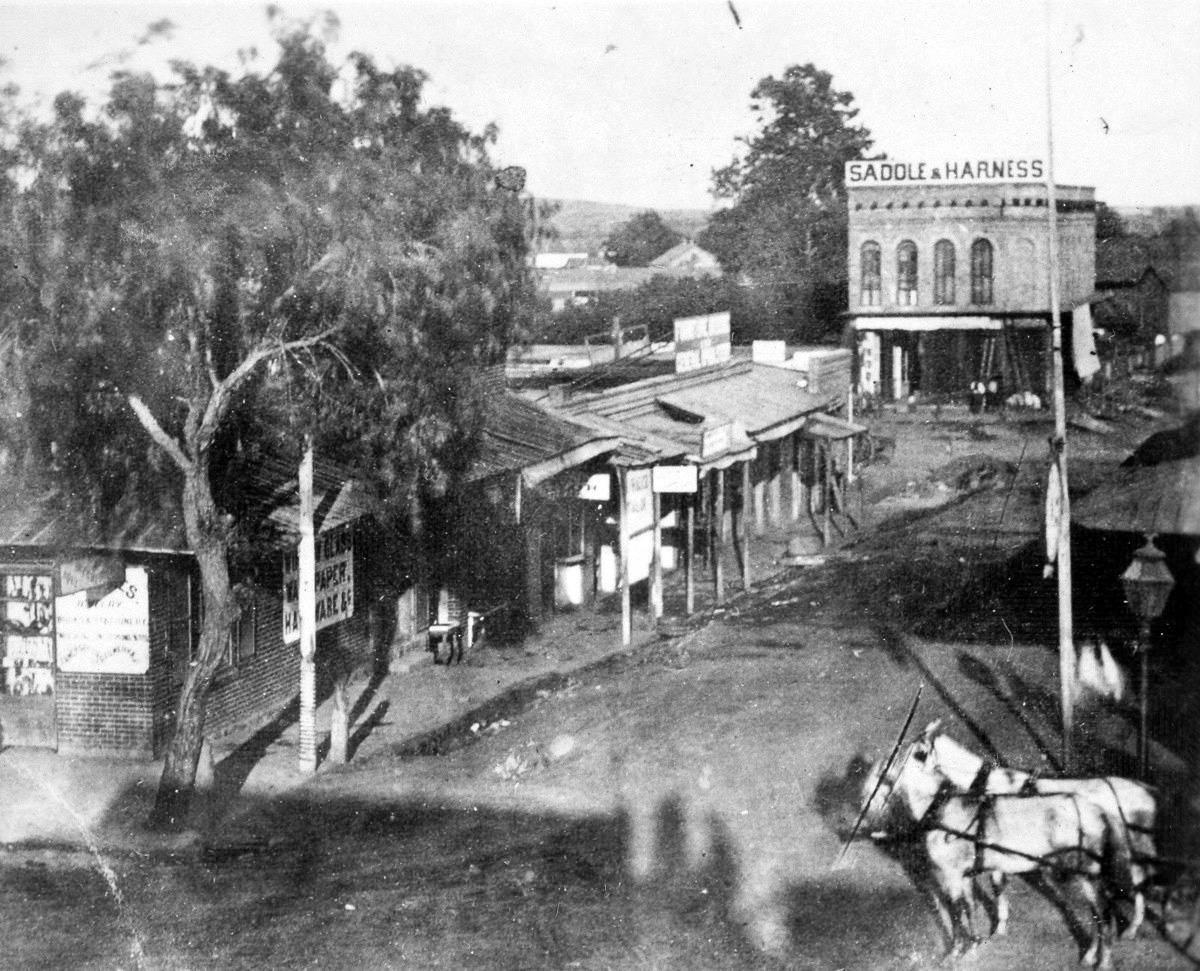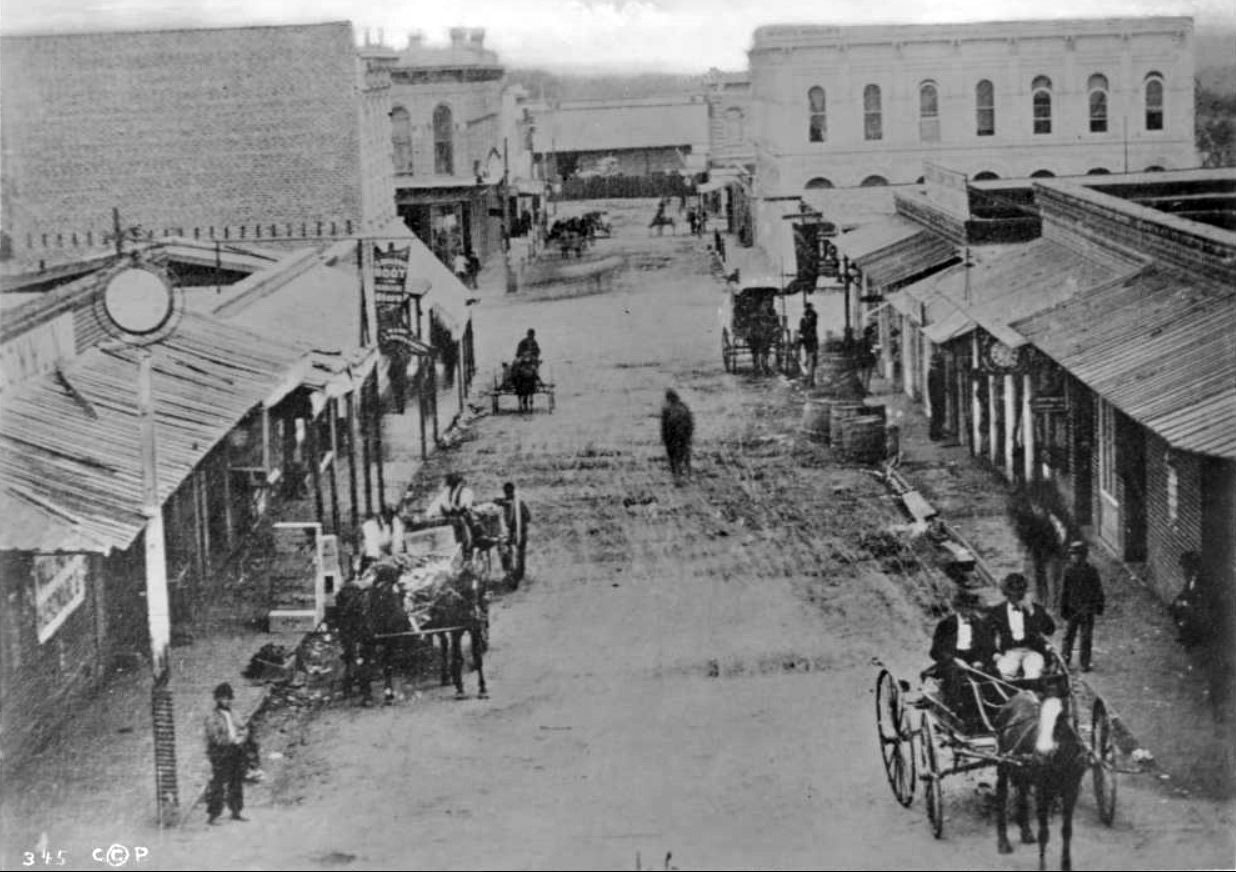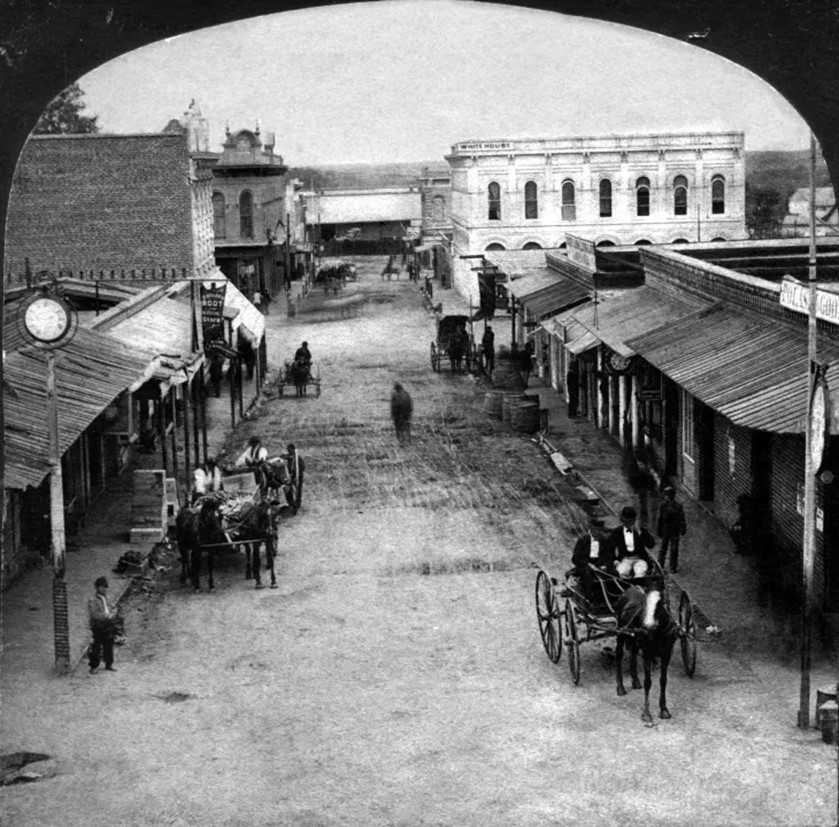Commercial Street (Downtown Los Angeles) |
 |
|
| (1869)* - Early view of Commercial Street, looking east from Main Street, just north of Temple Street, near the site of the later City Hall. On the right is Polaski and Goodwin's Dry Goods Store, sold to them by I.W. Hellman in 1868, and where the Farmers and Merchants Bank did business for years. Charles Ducommun operated a jewelry and hardware store in the building in left foreground. In the background is Herman Heinsch's Saddle and Harness shop, a newly-erected brick building. A gas street light is in the right foreground. |
Historical Notes This was Los Angeles’ principal business district. It was bounded by Commercial Street, which was only one block long and was located between Main and Los Angeles streets; Los Angeles Street, one block north from Commercial to Arcadia and Aliso streets; and Calle de los Negros, which extended north from Aliso to Plaza streets. Nearly all of the houses were built of adobe blocks, which are made of earth and straw and molded and dried in the sun, of a size twenty inches long, fourteen inches wide and five inches thick. There were about a dozen brick houses and a few frame dwellings. |
 |
|
| (1869)* - Early view of Commercial Street, looking east from Main Street, just north of Temple Street, near the site of the later City Hall. On the right is Polaski and Goodwin's Dry Goods Store, sold to them by I.W. Hellman in 1868, and where the Farmers and Merchants Bank did business for years. Charles Ducommun operated a jewelry and hardware store in the building in left foreground. In the background is Herman Heinsch's Saddle and Harness shop, a newly-erected brick building. One of LA's first gas streetlights* is seen at lower-right. |
Historical Notes Charles Louis Ducommun, a watchmaker by training, emigrated to the US from Switzerland in the early 1840s. He started a general store, providing supplies (and credit) to gold prospectors and other pioneers who had settled in the burgeoning pueblo of Los Angeles. In 1867, Los Angeles Gas Company, the forerunner of today's Southern California Gas Company, installed 43 new gas lamps along Main Street, making the city safer at night. The gas lighting business was run by five entrepreneurs who manufactured the gas from asphalt, a tar-like substance, and later from oil. Click HERE to see more in Early Los Angels Streetlights. |
 |
|
| Map highlighted to indicate the location and direction of the camera in the previous photo. |
Historical Notes Not surprisingly, Commercial Street is much changed from what it was nearly 150 years ago. For one thing the stretch shown in this photo is gone, as the section from Main to Alameda is now taken up with commercial and government buildings, including the regional office of the Internal Revenue Service, the Edward Roybal Federal Building and Metropolitan Detention Center. What remains are several blocks paralleling the 101 Freeway, built through the area in the 1950s, from Alameda (where the Gold Line runs over the intersection from Union Station south and then east into Boyle Heights and East Los Angeles ) east to the Los Angeles River. Parking structures and commercial buildings are along this largely non-descript portion of the roadway. |
 |
|
| (1872)* - View of Commercial Street, looking east from Main Street. The two-story White House Hotel is seen at far right on the southeast corner of Commercial and Los Angeles Streets. At left is one of the first two-story buildings built in Los Angeles, by I.W. Hellman in 1870. Ducommun Hardware is at the first left-hand corner. This was the business center of Los Angeles at the time. Horse-drawn carriages are in the unpaved street. |
Historical Notes Isaias Wolf Hellman was a German-born American banker and philanthropist, and a founding father of the University of Southern California. Commercial Street played a crucial role in the early commercial development of downtown Los Angeles in the late 19th century. Originally a short east-west street between Main and Los Angeles Streets, it became one of the city's main business districts in the late 1860s and 1870s. The street was lined with various shops and businesses, including Charles Ducommun's hardware and jewelry store, S. Nordlinger's watch and jewelry shop, Samuel Prager's general store, and the Los Angeles Carpet Warehouse. Several restaurants also contributed to the lively commerce that earned the street its name. The architecture of Commercial Street reflected the changing times, transitioning from original adobe structures to newer brick buildings by the late 1860s. It featured some of the first two-story commercial buildings in Los Angeles, marking the city's evolution from a small pueblo to a rapidly growing commercial center. This development coincided with Los Angeles' first major boom period following the Civil War. Commercial Street's historical significance is underscored by its documentation in early photography, which captured its role in the city's urban transformation. While much of the original street has been redeveloped, a short four-block stretch of East Commercial Street still exists today between Alameda Street and the Los Angeles River, serving as a reminder of the street's historic importance in modern Los Angeles. |
 |
|
| (1872)* - Stereoscopic photograph showing Commercial Street, looking east from Main Street. The view is taken from Main Street just north of Temple Street and the Temple Block, owned by F.P.F. Temple, and looks east down Commercial Street, also known as “New Commercial Street” in some sources. Commercial Street was an apt name because the length of this section was devoted exclusively to businesses and shops located in a variety of structures along the thoroughfare.* Photo by William M. Godrey, Homestead Collection. |
Historical Notes In the foreground left is the location of the hardware and jewelry store of Charles Ducommun, who settled in Gold Rush Los Angeles and who, within a couple of years, expanded his business with a two-story building and had frontage on both Commercial and Main streets. Today, Ducommun, Inc., provides electronic and structural manufacturing systems for aerospace, defense and general industry. Not surprisingly, Commercial Street is much changed from what it was nearly 150 years ago. For one thing the stretch shown in this photo is gone, as the section from Main to Alameda is now taken up with commercial and government buildings, including the regional office of the Internal Revenue Service, the Edward Roybal Federal Building and Metropolitan Detention Center. What remains are several blocks paralleling the 101 Freeway, built through the area in the 1950s, from Alameda (where the Gold Line runs over the intersection from Union Station south and then east into Boyle Heights and East Los Angeles ) east to the Los Angeles River. Parking structures and commercial buildings are along this largely non-descript portion of the roadway.* |
 |
|
| (1880)* - A stereograph view of Commercial Street, looking east from North Main Street. At left is a three-story furniture and dry goods store owned by S. Prager. At far right distance is the White House Hotel. Horse-drawn wagons are visible on the street. |
Historical Notes Commercial Street played a crucial role in the early commercial development of downtown Los Angeles in the late 19th century. Originally, it was a shorter east-west street stretching for about one block between Main Street and Los Angeles Street, just north of Temple Street (It later was extended furthe east). In the late 1860s and 1870s, Commercial Street became one of the city’s main business districts. It was lined with various shops and businesses, including Charles Ducommun’s hardware and jewelry store, Polaski and Goodwin’s Dry Goods Store, the White House Hotel, S. Nordlinger’s watch and jewelry shop, Samuel Prager’s general store, and the Los Angeles Carpet Warehouse. Several restaurants also contributed to the lively commerce that earned the street its name. The architecture of Commercial Street reflected the changing times. Many original buildings were adobe, but by the late 1860s, newer brick structures began to appear. It also featured some of the first two-story commercial buildings in Los Angeles, marking the city’s transition from a small pueblo to a rapidly growing commercial center. This development coincided with Los Angeles' first major boom period following the Civil War. |
 |
|
| (ca.1882)* - Hardware Store of C. Ducommun, dry goods store of S. Prager and a furniture store at 204 N. Main Street (after 1890 at 304 N. Main Street) are shown. The 1883-4 edition of the city directory lists C. Ducommun Hardware at this location. This was the NE corner of Main and Commercial streets. |
Historical Notes In the late 1860s, Charles Ducommun operated a jewelry and hardware store located on the northeast corner of Main and Commercial streets, which was part of Los Angeles' principal business district at that time. Charles Louis Ducommun, a watchmaker who emigrated from Switzerland to the United States in the early 1840s, established his business in 1849, making it one of the oldest continually operating companies in California. Initially starting as a general store in Los Angeles, Ducommun's business grew to include jewelry and hardware. During the Gold Rush era, the store primarily sold accessories and supplies to prospectors heading north. As the decades passed, Ducommun's enterprise evolved, expanding into metal manufacturing and eventually specializing in aerospace components. Click HERE to see more on the Ducommun Building. |
 |
|
| (ca. 1900)* – View looking west on Commercial Street from Los Angeles Street toward Main Street, with the 1870-built Hellman Building located on the northwest corner to the right. Photo from the Ernest Marquez Collection. |
Historical Notes The Hellman Building, a two-story brick structure on the northwest corner of Los Angeles and Commercial Streets, was built by the Hellman family in 1870. Located in a bustling commercial area, it housed notable tenants like Ezra F. Kysor, Los Angeles' first architect, and various shops. The building symbolized both the city's growing economic significance and the Hellman family's role in its development during the late 19th century. |
 |
|
| (1950)* – View of the Ducommun Block at the northeast corner of Main and Commercial Streets, featuring the Federal Hotel, Federal Photo Studio, Security First National Bank, and the Donut King restaurant next door on the left. An elderly lady is seated on a marble bench in the foreground. Photo by Arnold Hylen. |
Historical Notes None of these buildings remain today, and the portion of Commercial Street visible on the right has been redeveloped. The area from Main to Alameda is now occupied by commercial and government buildings, including the regional office of the Internal Revenue Service, the Edward Roybal Federal Building, and the Metropolitan Detention Center. |
 |
|
| (ca.1950)* - Main Street, looking northeast toward Commercial Street, with the Ducommun Block and Security First National Bank on the corner. Photo by Arnold Hylen. |
 |
|
| (1950)* – View of the northwest corner of Los Angeles and Commercial Streets, showing a two-story brick building with the "Italian Kitchen" restaurant on the ground level in the foreground and the Federal Building in the background. Photo by Arnold Hylen. |
 |
|
| (1950)* – View looking southwest toward the intersection of Los Angeles Street and Commercial Street, with City Hall in the background. In the foreground are two- and three-story brick buildings housing restaurants, hotels, and other shops. Photo by Arnold Hylen. |
 |
|
| (1951)* – Aerial view from City Hall, looking toward the intersection of Commercial and San Pedro Streets at the lower center. TAIX restaurant is visible just east of the intersection. Los Angeles Street runs diagonally at the lower left, while Aliso Street, now the 101 Freeway, passes by Union Station at the center left. Note the large gasometers at the upper right. Photo by Arnold Hylen. |
Historical Notes Marius Taix established the original Taix French Restaurant in the heart of downtown Los Angeles. The restaurant was located at 321 Commercial Street. It was known for its affordable, hearty French country cuisine and community-style dining, where meals were served at long, communal tables. This setup was reflective of the dining style in French inns. |
 |
|
| (1959)* – Commercial Street, looking west from San Pedro Street past Los Angeles Street, toward the dead end at Main Street, where the U.S. Post Office and Courthouse Building stands. The small 2-story building on the northeast corner Commercial and Los Angeles Streets is a hotel. |
 |
|
| (1959)* - Commercial Street, looking east from the U.S. Post Office and Courthouse on Main Street toward Los Angeles Street. A hotel is on the left, and a luggage store is on the right. Commercial Street is a one-way street. |
 |
|
| (ca.1959)* - Commercial Street, looking east from Los Angeles Street, showing the Heinsch Building (built 1869). The building in the foreground houses The Tama Trading Co., located at 213-221 East Commercial Street at San Pedro Street. A partially-hidden sign across San Pedro Street is for TAIX French Restaurant located at 321 East Commercial Street. |
 |
|
| (1961)* – Two blocks of Commercial Street, from Main Street to Los Angeles Street and San Pedro Street. The Security First National Bank branch at 302 North Main Street is on the left, where the Ducommun Building once stood. Photo by Palmer Conner. |
Historical Notes Not surprisingly, Commercial Street is much changed from what it was nearly 150 years ago. For one thing the stretch shown in this photo is gone, as the section from Main to Alameda is now taken up with commercial and government buildings, including the regional office of the Internal Revenue Service, the Edward Roybal Federal Building and Metropolitan Detention Center. What remains are several blocks paralleling the 101 Freeway, built through the area in the 1950s, from Alameda (where the Gold Line runs over the intersection from Union Station south and then east into Boyle Heights and East Los Angeles ) east to the Los Angeles River. Parking structures and commercial buildings are along this largely non-descript portion of the roadway. |
Then and Now
 |
|
| (1950 vs 2022)* - Looking east toward the Ducommun Building on the northeast corner of Main and Commercial Streets where today stands the Los Angeles Mall and a walkway where Commercial Street once existed. |
 |
|
| (2024)* - Google Map showing the remaining four short blocks of Commercial Street in downtown Los Angeles. It now runs from Alameda Street on the west to the Los Angeles River on the east. |
Historical Notes What remains of Commercial Street today are several blocks paralleling the 101 Freeway, built through the area in the 1950s, from Alameda (where the Gold Line runs over the intersection from Union Station south and then east into Boyle Heights and East Los Angeles ) east to the Los Angeles River. Parking structures and commercial buildings are along this largely non-descript portion of the roadway. |
* * * * * |
|
Other Sections of Interest |
|
Water and Power in Early LA |
|
Newest Additions |
New Search Index |

A new SEARCH INDEX has been added to help navigate through the thousands of topics and images found in our collection. Try it out for a test run.
Click HERE for Search Index |
* * * * * |
< Back
Menu
- Home
- Mission
- Museum
- Major Efforts
- Recent Newsletters
- Historical Op Ed Pieces
- Board Officers and Directors
- Mulholland/McCarthy Service Awards
- Positions on Owens Valley and the City of Los Angeles Issues
- Legislative Positions on
Water Issues
- Legislative Positions on
Energy Issues
- Membership
- Contact Us
- Search Index
© Copyright Water and Power Associates
Layout by Rocket Website Templates